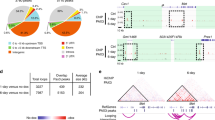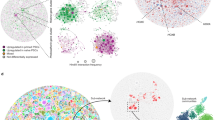Abstract
The genome is folded into domains located in compartments that are either transcriptionally inert or transcriptionally permissive. Here we used genome-wide strategies to characterize domains during B cell development. Structured interaction matrix analysis showed that occupancy by the architectural protein CTCF was associated mainly with intradomain interactions, whereas sites bound by the histone acetyltransferase p300 or the transcription factors E2A or PU.1 were associated with intra- and interdomain interactions that are developmentally regulated. We identified a spectrum of genes that switched nuclear location during early B cell development. In progenitor cells, the transcriptionally inactive locus encoding early B cell factor (Ebf1) was sequestered at the nuclear lamina, which thereby preserved their multipotency. After development into the pro-B cell stage, Ebf1 and other genes switched compartments to establish new intra- and interdomain interactions associated with a B lineage–specific transcription signature.
This is a preview of subscription content, access via your institution
Access options
Subscribe to this journal
Receive 12 print issues and online access
$209.00 per year
only $17.42 per issue
Buy this article
- Purchase on Springer Link
- Instant access to full article PDF
Prices may be subject to local taxes which are calculated during checkout







Similar content being viewed by others
Accession codes
References
Sedat, J. & Manuelidis, L. A direct approach to the structure of eukaryotic chromosomes. Cold Spring Harb. Symp. Quant. Biol. 42, 331–350 (1977).
Rattner, J.B. & Lin, C.C. Radial loops and helixcal coils coexist in metaphase chromosomes. Cell 42, 291–296 (1985).
Paulson, J.R. & Laemmli, U.K. The structure of histone depleted metaphase chromosomes. Cell 12, 817–828 (1977).
Pienta, K.J. & Coffey, D.S. A structural analysis of the nuclear matrix and DNA loops in the organization of the nucleus and chromosome. J. Cell Sci. (suppl. 1), 123–135 (1984).
Munkel, C. & Langowski, J. Chromosome structure described by a polymer model. Phys. Rev. E Stat. Phys. Plasmas Fluids Relat. Interdiscip. Topics 575B, 5888–5896 (1998).
Jhunjhunwala, S. et al. The 3D-structure of the immunoglobulin heavy chain locus: Implications for long-range genomic interactions. Cell 133, 265–279 (2008).
Bau., D. et al. The three-dimensional folding of the α-globin gene domain reveals formation of chromatin globules. Nat. Struct. Mol. Biol. 18, 107–114 (2011).
Guo, C. et al. Two forms of loops generate the chromatin conformation of the immunoglobulin heavy chain locus. Cell 147, 332–343 (2011).
Peric-Hupkes, D. et al. Molecular maps of the reorganization of genome-nuclear lamina interactions during differentiation. Mol. Cell 38, 603–613 (2010).
Schneider, R. & Grosschedl, R. Dynamics and interplay of nuclear architecture, genome organization and gene expression. Genes Dev. 21, 3027–3043 (2007).
Brown, K.E., Baxtger, J., Graf, D., Merkenschlager, M. & Fisher, A.G. Dynamic repositioning of genes in the nucleus of lymphocytes preparing for cell division. Mol. Cell 3, 207–217 (1999).
Kosak, S.T. et al. Subnuclear compartmentalization of immunoglobulin loci during lymphocyte development. Science 296, 158–162 (2002).
Fuxa, M. et al. Pax5 induces V-DJ rearrangements and locus contraction of the immunoglobulin heavy-chain gene. Genes Dev. 18, 411–422 (2004).
Roldán, E. et al. Locus 'decontraction' and centromeric recruitment contribute to allelic exclusion of the immunoglobulin heavy-chain gene. Nat. Immunol. 6, 31–41 (2005).
Hewitt, S.L., Chaumeil, J. & Skok, J.A. Chromosome dynamics and the regulation of V(D)J recombination. Immunol. Rev. 237, 43–54 (2010).
Goldmit, M. et al. Epigenetic ontogeny of the IgK locus during B cell development. Nat. Immunol. 6, 198–203 (2005).
Lieberman-Aiden, E. et al. Comprehensive mapping of long-range interactions reveals folding principles of the human genome. Science 326, 289–293 (2009).
Fullwood, M.J. et al. An oestrogen-receptor-α-bound human chromatin interactome. Nature 462, 58–64 (2009).
Kalhor, R., Tjong, H., Jayathilaka, N., Alber, F. & Chen, L. Genome architectures revealed by tethered chromosome conformation capture and population-based modeling. Nat. Biotechnol. 30, 90–98 (2011).
Sexton, T. et al. Three-dimensional folding and functional organization principles of the Drosophila genome. Cell 148, 458–472 (2012).
Li, G. et al. Extensive promoter-centered chromatin interactions provide a topological basis for transcription regulation. Cell 148, 84–98 (2012).
Zhang, Y. et al. Spatial organization of the mouse genome and its role in recurrent chromosomal translocations. Cell 148, 908–921 (2012).
Dixon, J.R. et al. Topological domains in mammalian genomes identified by analysis of chromatin interactions. Nature 485, 376–380 (2012).
Siepel, A. et al. Evolutionarily conserved elements in vertebrate, insect, worm, and yeast genomes. Genome Res. 15, 1034–1050 (2005).
Dawson, M.A. & Kouzarides, T. Cancer epigenetics: from mechanism to therapy. Cell 150, 12–27 (2012).
Schmidt, D. et al. Waves of retrotransposon expansion remodel genome organization and CTCF binding in multiple mammalian lineages. Cell 148, 335–348 (2012).
Ochiai, K. et al. A self-reinforcing regulatory network triggered by limiting IL-7 activates pre-BCR signaling and differentiation. Nat. Immunol. 13, 300–307 (2012).
Chen, X. et al. Integration of external signaling pathways with the core transcriptional network in embryonic stem cells. Cell 133, 1106–1117 (2008).
Heinz, S. et al. Simple combinations of lineage-determining transcription factors prime cis-regulatory elements required for macrophage and B cell identities. Mol. Cell 38, 576–589 (2010).
Lin, Y.C. et al. A global network of transcription factors, involving E2A, EBF1 and Foxo1, that orchestrates B cell fate. Nat. Immunol. 11, 635–643 (2010).
Iborra, F.J., Pombo, A., Jackson, D.A. & Cook, P.R. Active RNA polymerase are localized within discrete transcription factories in human nuclei. J. Cell Sci. 109, 142–2436 (1996).
Edelman, L.B. & Fraser, F. Transcription factories: genetic programming in three dimensions. Curr. Opin. Gen. Dev. 22, 110–114 (2012).
Corcoran, A.E. The epigenetic role of non-coding RNA transcription and nuclear organization in immunoglobulin repertoire generation. Semin. Immunol. 6, 353–361 (2010).
Simonis, M. et al. Nuclear organization of active and inactive chromatin domains uncovered by chromosome capture-on-chip (4C). Nat. Genet. 38, 1348–1354 (2006).
Jhunjhunwala, S., van Zelm, M.C., Peak, M. & Murre, C. Chromatin architecture and the generation of antigen receptor diversity. Cell 138, 435–448 (2009).
Inlay, M.A., Tina, H., Lin, T. & Xu, Y. Important roles for E protein binding sites within the immunoglobulin kappa chain intronic enhancer in activating Vκ to Jκ rearrangement. J. Exp. Med. 200, 1205–1211 (2004).
Romanow, W.J. et al. E2A and EBF act in synergy with the V(D)J recombinase to generate a diverse immunoglobulin repertoire in non-lymphoid cells. Mol. Cell 5, 343–353 (2000).
Sakamoto, S. et al. E2A and CBP/p300 act in synergy to promote chromatin accessibility of the immunoglobulin κ locus. J. Immunol. 188, 5547–5560 (2012).
Bossen, C., Mansson, R. & Murre, C. Chromatin topology and the regulation of antigen receptor assembly. Annu. Rev. Immunol. 30, 337–356 (2012).
Li, L., Leid, M. & Rothenberg, E.V. An early T cell lineage commitment checkpoint dependent on the transcription factor Bcl11b. Science 329, 89–93 (2010).
Ikawa, T. et al. An essential developmental checkpoint for production of the T cell lineage. Science 329, 93–96 (2010).
Li, P. et al. Reprogamming of T cells to natural killer-like cells upon Bcl11b deletion. Science 329, 85–89 (2010).
Welinder, E. et al. E2A and HEB act in concert to induce the expression of FOXO1 in the common lymphoid progenitor. Proc. Natl. Acad. Sci. USA 108, 17402–17407 (2011).
Seet, C.S., Brumbaugh, R.L. & Kee, B.L. Early B cell factor promotes B lymphopoiesis with reduced interleukin 7 responsiveness in the absence of E2A. J. Exp. Med. 199, 1689–1700 (2004).
Semerad, C.L., Mercer, E.M., Inlay, M.A., Weissman, I.L. & Murre, C. E2A proteins maintain the hematopoietic stem cell pool and promote the maturation of myelolymphoid and myeloerythroid progenitors. Proc. Natl. Acad. Sci. USA 106, 1930–1935 (2009).
Zullo, J.M. et al. DNA sequence-dependent compartmentalization and silencing of chromatin at the nuclear lamina. Cell 149, 1474–1487 (2012).
Ikawa, T., Kawamoto, H., Wright, L.Y. & Murre, C. Long-term cultured E2A-deficient hematopoietic progenitor cells are pluripotent. Immunity 20, 349–360 (2004).
Sayegh, C.E., Jhunjhunwala, S., Riblet, R. & Murre, C. Visualization of looping involving the immunoglobulin heavy-chain locus in developing B cells. Genes Dev. 22, 322–327 (2005).
Acknowledgements
We thank G. Hardiman, C. Ludka, L. Edsall, S. Kuan, C. Espinoza, U. Wagner, J. Sprague and Z. Ye for help with Solexa DNA sequencing; J. Dixon for help during the initial phase of Hi-C analysis; B. Wold for suggesting fixation with ethylene glycol bis(succinimidylsuccinate); B. Ren for access to the Illumina Hi-Seq; and members of the Murre laboratory for comments on the manuscript. Supported by the American Recovery and Reinvestment Act (ARRA PHS 3RO1AI082850 to Y.C.L.), the European Molecular Biology Organization (C.Bo.), the Swiss National Science Foundation (C.Bo.), the University of California San Diego, Cancer Center (P30 CA23100) and the US National Institutes of Health (AI082850A and AI00880 to C.K.G. and C.M.).
Author information
Authors and Affiliations
Contributions
R.M. and S.H. contributed equally to this work. Y.C.L., R.M. and S.H. designed and did most of the experiments; S.H. did Gro-Seq analysis; C.Be. did the bioinformatics analysis, analyzed data, suggested new approaches and developed SIMA; M.M., K.M. and V.C. did chromatin immunoprecipitation followed by deep sequencing; C.Bo. provided insight into the topology of the Igk locus; Y.C.L., C.Be. and C.M. wrote the manuscript with contributions from C.K.G., R.M. and S.H.; and C.K.G. and C.M. supervised the study.
Corresponding authors
Ethics declarations
Competing interests
The authors declare no competing financial interests.
Supplementary information
Supplementary Text and Figures
Supplementary Figures 1–7 and Tables 1–3 and Supplementary Methods (PDF 8652 kb)
Rights and permissions
About this article
Cite this article
Lin, Y., Benner, C., Mansson, R. et al. Global changes in the nuclear positioning of genes and intra- and interdomain genomic interactions that orchestrate B cell fate. Nat Immunol 13, 1196–1204 (2012). https://doi.org/10.1038/ni.2432
Received:
Accepted:
Published:
Issue Date:
DOI: https://doi.org/10.1038/ni.2432
This article is cited by
-
Enhancer-instructed epigenetic landscape and chromatin compartmentalization dictate a primary antibody repertoire protective against specific bacterial pathogens
Nature Immunology (2023)
-
The role of chromatin loop extrusion in antibody diversification
Nature Reviews Immunology (2022)
-
Dynamics of genome architecture and chromatin function during human B cell differentiation and neoplastic transformation
Nature Communications (2021)
-
Genome organization in immune cells: unique challenges
Nature Reviews Immunology (2019)
-
Chromosome dynamics near the sol-gel phase transition dictate the timing of remote genomic interactions
Nature Communications (2019)



